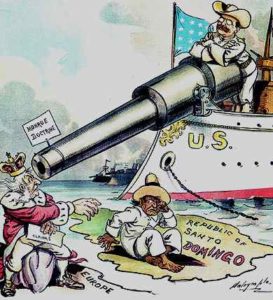Roosevelt Corollary
noun U.S. History.
Origin of Roosevelt Corollary
HOMEWORK HELP
What was the Roosevelt Corollary?
The Roosevelt Corollary was a United States foreign policy established by President Theodore Roosevelt in 1904. It stated that the U.S. would intervene in Latin American countries where European powers sought to collect debts or whose governments were thought to be unstable.
A corollary, in the general sense, is a natural consequence or result. In this context, it indicates that the Roosevelt Corollary was an extension of the Monroe Doctrine, a U.S. policy established in 1823 stating that the United States opposed any European interference in the Western Hemisphere.
The Roosevelt Corollary was conceived as a means to protect U.S. interests and preserve stability in Latin America by preventing European countries from interfering there. However, it came to be used as a justification for the U.S. to intervene in Latin American internal affairs and expand its influence in the region.
Roosevelt Corollary vs. Monroe Doctrine
Back in 1823, President James Monroe articulated the landmark policy that would become known as the Monroe Doctrine, stating that European powers should not interfere with or further colonize countries in the Americas. In return, he said the United States would not interfere in European matters.
Eighty-one years later, President Theodore Roosevelt—known for modeling his foreign policy on the proverb “Speak softly and carry a big stick”—gave a speech to Congress in which he outlined what became known as the Roosevelt Corollary. In it, he tied his foreign policy approach to the Monroe Doctrine, stating that the U.S. may be forced to use “international police power” to intervene when countries in the Americas engaged in “wrongdoing” that invited interference from European powers.
Roosevelt was referring to incidents like the Venezuela Crisis, in which Venezuela was blockaded by Britain, Germany, and Italy in an attempt to forcefully collect debts that it had defaulted on. Roosevelt’s stated goal was to keep European influence out of the region by preserving stability in the Americas—by force, if necessary. But the policy was soon (and frequently) used as justification for the U.S. to intervene in various Latin American affairs and assert its dominance in the region. (Ironically, that’s exactly what the Monroe Doctrine was intended to prevent European nations from doing.)
Another Roosevelt, President Franklin Delano Roosevelt, is often credited with turning U.S. foreign policy away from the type of interventionism promoted by the Roosevelt Corollary. But the effects of the Roosevelt Corollary are still relevant. Criticism of U.S. expansionism and debates about its role as the “world’s policeman” continue to be topics in world politics.
Did you know … ?
The Roosevelt Corollary is not the only thing named after Theodore “Teddy” Roosevelt. After a hunting trip during which Roosevelt was reported to have spared a bear, cartoonist Clifford Berryman introduced a “teddy bear” character. The association stuck and toy dealers capitalized by selling stuffed bear toys, forever after known as teddy bears.
What are real-life examples of Roosevelt Corollary?
From the start, the Roosevelt Corollary has been a topic of debate, and still factors into political discourse about United States foreign policy more than 100 years later.
He was quoting the Roosevelt Corollary, which was a foreign policy that focused on showing that America had power, but keeping calm. No need to attack an 18 year old kid who knows more history than you.
— Sabrina (@SabrinaStrats) July 23, 2018
Neither is it afraid to confuse the Monroe Doctrine with the Roosevelt Corollary, apparently. https://t.co/SMYpBzk7pK
— Alex Usher (@AlexUsherHESA) March 3, 2019
What other words are related to Roosevelt Corollary?
Quiz yourself!
True or false: The Roosevelt Corollary was a pact between the United States and other countries in the Western Hemisphere to join forces against European powers.

